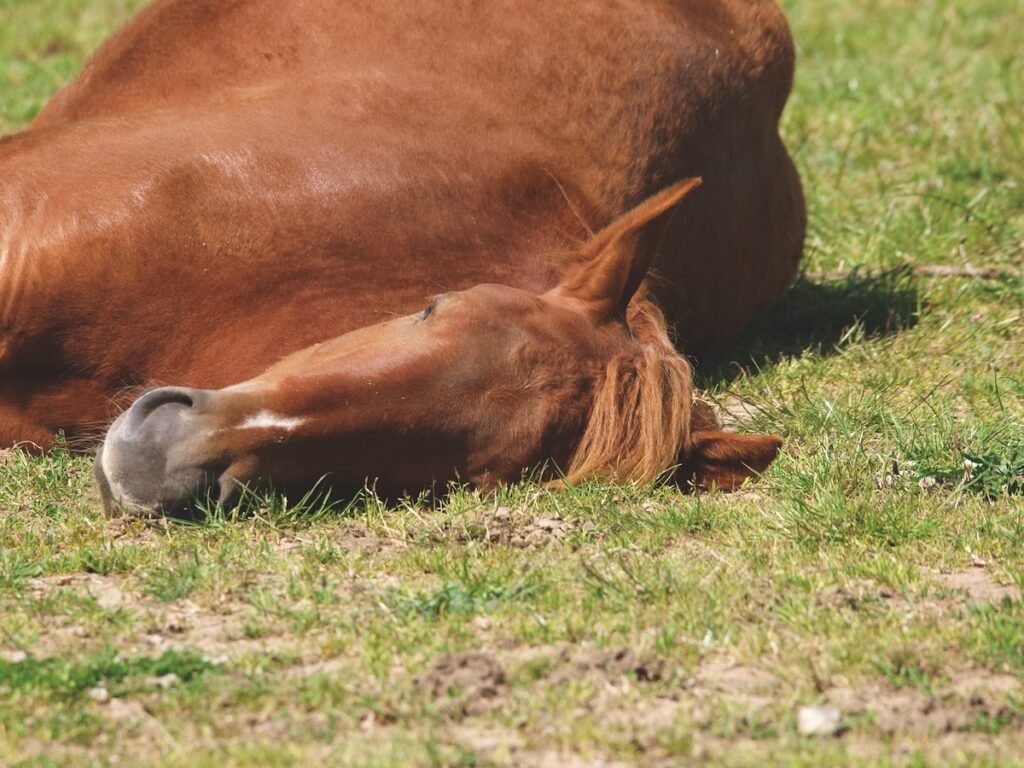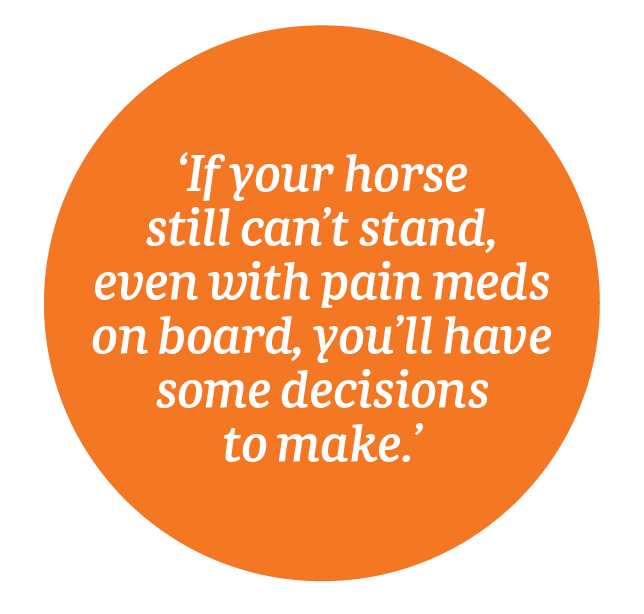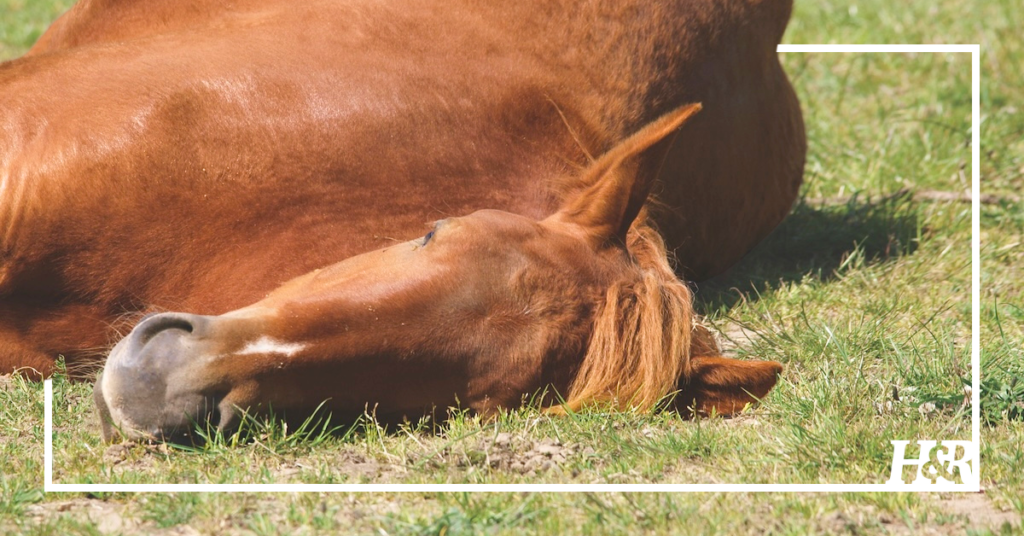Death, taxes, and a down horse. The first two are on top of almost everybody’s list of things to avoid. If you’re a horse person, number three ranks just about as high. A downed horse is one that’s down on the ground and can’t get up, usually because it’s injured, ill, or simply stuck. No matter the reason, getting a downed horse back on its feet can be the stuff of nightmares. And everyone who owns a horse should know what steps to take if they ever find themselves dealing with a horse that’s on the ground.
In this article, we’ll look at the reasons a horse might go down and be unable to get up. Then we’ll discuss the (sometimes hard) questions you’ll need to ask and answer to make sure you keep your horse’s best interests in mind as you work to get him up. Finally, we’ll outline a seven-step plan to help you assess the situation and take the necessary actions.

Why Does a Horse Go Down?
There are so many reasons why you might find your horse down on the ground and unable to get up. Some are as simple as being cast against the wall of his stall, and others are much more complicated, like a neurological problem that has caused him to become paralyzed or a severe colic episode. One thing is certain, determining the certain reasons why your horse is down is essential. It’s also true that the best solution for your horse doesn’t always mean back on his feet. Sometimes, it means euthanasia.
It’s a harsh reality. In a 2014 study examining likely outcomes of downed horses that presented to the teaching hospital at the University of California-Davis, only 26% survived. You love your horse. You’d do anything to save his life. You also know that you’d never want to see him suffer needlessly. And when a horse goes down and can’t get up, the reality is that euthanasia may be the kindest decision you can make. You want to give your horse a chance, but you especially don’t want to put your horse through extensive stressful or even painful procedures during his final hours.
So how can you tell whether your horse is likely to get up? While you don’t need to make a specific diagnosis (leave that to your veterinarian!) there are some important questions you can ask that may help you determine what the future holds.
Question #1: Has your horse been robust and healthy? Or is he older with multiple health issues that have been progressively harder and harder to manage? If your horse’s quality of life was questionable before you found him down, it’s likely to stay that way even when you get him up. It’s OK to make the decision to skip the heroic efforts. In fact, it might even be the kindest choice. Even if you do have access to an experienced team and all the tools that you might need to successfully get your horse back on his feet, you have to ask yourself the question, is it fair?
Question #2: Is there evidence of severe injury or illness that likely can’t be treated? Your vet can help you with this question. But be aware, you might not have an answer until they’ve done some diagnostic tests, such as radiographs if they suspect a fracture, or even basic treatments like pain medications or intravenous fluids. If your horse was healthy yesterday, and you found him down today, you’ll definitely want to do what you can to help him back to his feet. But if he has a severe injury or fails to respond to any treatment efforts, it may not be in his best interests to keep on trying.
Question #3: Is the environment impossible? We’ve all heard stories about heroic rescue efforts from the sides of cliffs, complete with slings and helicopters. If you have those things available, great! But if they’re not, and your horse is upside down in deep mud on a steep hillside with no vehicle access, you may not have a lot of options. This can be the most difficult scenario of all when you have to make a difficult decision.
If Your Horse Is Down and Can’t Get Up: A Seven-Step Plan
With those guardrails in place, what steps should you take if your horse is down and can’t get up?
Step 1: Stand Back and Assess
When you find your horse down, it’s instinctive to want to jump right in and help. Don’t! A down horse can be extremely dangerous. Take a minute to assess the situation. Can you approach your horse easily from behind? Is he in a position where you could get trapped in a stall or against a paddock fence? And perhaps most important, is there someone nearby to help? It’s essential that you stay safe. After all, if you get crushed by your horse when he tries to stand, you won’t be able to help him much. Take a minute. Take a breath. And make a plan.
Step 2: Establish a Team
At minimum you should have one other person available just in case you do get hurt. And three or four experienced horse handlers who will remain calm can be a big help. While you are gathering your team, call your vet. Let them know your horse is down. Even if you do manage to get your horse up before your vet arrives, it’s best to have them on the way. An examination is likely to be warranted even if your horse is standing, and the amount of time a horse remains down is one of the biggest factors in a successful outcome. Having your vet there as soon as possible can made a difference.
Step 3: Communicate Safety Rules
Before you even try to help your horse get up, make sure your team knows how to stay safe. Never position yourself by your horse’s legs. Even if it seems like he is hardly moving, you’d be amazed at how strong those legs can be if he decides to thrash around. Approach from the back. If he’s in a stall or other confined area, avoid putting yourself in a position where you can get trapped against a wall, and always plan an escape route. If you do have to go into a confined area, make sure the whole team knows what your escape route is and how important it is that they stay out of the way if things go sideways.

Step 4: Check Leg Positioning
As a general rule, a horse needs to get sternal (up on his chest, rather than flat out on his side) to get up. He’ll bring his forelimbs out in front of his body and push off with his hindlegs. If your horse is cast, laying with his feet against a stall wall, or down in a pasture with his legs pointed uphill, rolling him over is the first thing you’ll need to try. To safely roll a horse, you’ll typically need a minimum of three people, one on the front legs, one on the hind legs, and one on the head. You’ll need to loop a soft cotton rope around the front and hind pasterns of the down legs. Remember, only approach your horse from the back side, which means reaching across his body with your ropes looped to snare his hind legs. Pay close attention when you’re doing this, and keep your head out of firing range. Once your ropes are in place, you should be able to roll him over to his other side while your third helper guides his head. And be aware, if he were simply stuck, he might move fast if he decides to jump to his feet.
Step 5: Try Gentle Encouragement
If your horse just needed to be repositioned, some gentle encouragement may be all it takes to get him on his feet. Cluck, clap your hands, or even pester him a little bit by putting your fingers in his ears. A tool that can be useful at this stage in the game is a regular broom that you can use to brush his backside or (carefully) around his face. If he’s making a strong effort to get up and you have some space, a little forward pressure on the lead rope might help him find his feet. Once again, be extra careful at this point in the process. When he does stand up, he may be a little unsteady, and if you’re applying forward pressure with the rope, he’s likely to lurch forward.
Step 6: Try a Little Harder
As you watch your horse making attempts to stand, notice whether the ground underneath his feet allows him to gain purchase. If it’s slippery and he can’t keep his feet where they need to be, not only will it make it harder for him to stand, but it’ll also increase the chances that he’ll hurt himself if he does. Anything you can do to make the ground more stable, such as dumping sand, wood shavings, or even hay, can help. If the surface is icy, consider trying clay cat litter that will absorb water on the surface to help gain traction. You might also be able to help your horse by placing a large, heavy bale of hay up against his shoulder on his non-leg side. This can help him stay in a sternal position and will give him something he can push against as he tries to stand.
Once you’ve taken these steps, it’s time to get a little bit more aggressive in your efforts to encourage him to get up. Louder noises and more active efforts to annoy him might be what he needs. But beware. It’s a fine line. This is the point where you need to ask yourself how much is too much. And hopefully, your veterinarian has arrived by now to guide your way.
Step 7: Turn to Your Vet
When your vet arrives, they’ll start by taking the same first step you did, standing back to assess the situation. They’ll perform as much of an examination as possible to assess your horse’s status and try to determine what’s wrong. They may opt to give your horse an intravenous dose of an anti-inflammatory medication, such as phenylbutazone or flunixin meglumine.
If your horse still can’t stand, even with pain meds on board, you’ll have some decisions to make. Your vet will give you an assessment of your horse’s condition, and will outline the options you may have available for diagnostics and supportive treatments. They’ll also know how to access whatever rescue resources may be available in your area. If it’s warranted, they’ll even be able to assist with getting your horse into a transport vehicle for a trip to a referral hospital. Perhaps most important? They’ll support you if you have to make a difficult decision.
To Hotshot or Not? A Word About Noxious Stimuli
The reality of dealing with a down horse—especially for those of us without slings, winches, or specialized rescue gear—is that the horse has to participate. While we can take steps to put them in a position where it will be easier to stand, we simply can’t pick them up, no matter how hard we try. One of the strategies we often turn to is noxious stimuli. In other words, we do something they don’t like to encourage them to try a little harder.
Common examples include clapping, shouting, putting fingers in their ears, or gently pestering them with a broom. If those fail, some might consider escalating to making noise with a whip.
But where do we draw the line? This is where things get ethically murky. If your horse isn’t physically able to stand, no amount of provocation will change that—and pushing too hard can cause further harm or unnecessary suffering. In extreme cases, efforts to force a down horse to rise have led to tragic outcomes and public controversy.
Let this serve as a reminder: Sometimes, despite our best intentions, the kindest and most humane choice is to stop trying. Knowing when to let go is just as important as knowing when to fight for another chance.
—H&R—

